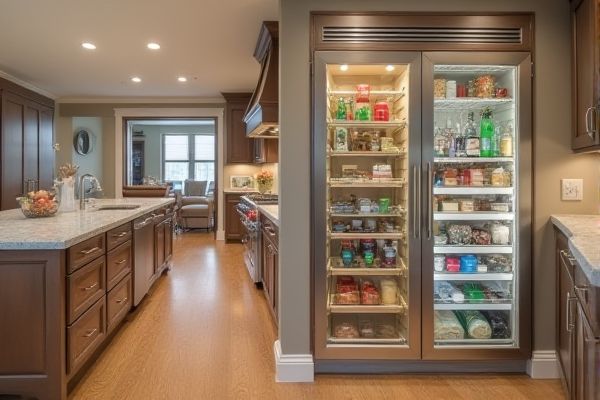
A dual temperature pantry offers separate zones for storing different foods at optimal temperatures, preserving freshness longer compared to a single temperature pantry that maintains only one consistent environment. Explore the advantages and key differences to determine which pantry setup best supports Your food storage needs.
Table of Comparison
| Feature | Dual Temperature Pantry | Single Temperature Pantry |
|---|---|---|
| Temperature Zones | Two separate temperature zones for different food storage needs | One uniform temperature zone |
| Food Storage Versatility | Optimized for both fresh and perishable items | Best for uniformly temperature-sensitive products |
| Energy Efficiency | May consume more energy due to dual cooling systems | Typically more energy-efficient with single cooling |
| Price | Generally more expensive due to advanced technology | More affordable and cost-effective |
| Use Case | Ideal for households or businesses needing flexible food storage | Suitable for simple storage needs |
Introduction to Dual Temperature vs Single Temperature Pantries
Dual temperature pantries offer the advantage of maintaining separate temperature zones, ideal for storing both wine and perishables at their optimal conditions. Single temperature pantries operate at one uniform temperature, suitable for general food storage but less efficient for items requiring precise climate control. Choosing between dual and single temperature pantries depends on the specific storage needs and the type of items to be preserved.
How Dual Temperature Pantries Work
Dual temperature pantries work by utilizing separate climate zones within a single unit, allowing precise control of both hot and cold storage areas. This system employs advanced insulation and independent temperature controls to maintain optimal conditions for preserving perishable foods and beverages simultaneously. Your ability to store diverse items, from chilled drinks to fresh produce, is enhanced without compromising quality or freshness.
Overview of Single Temperature Pantries
Single temperature pantries maintain a consistent climate ideal for storing specific categories of food, such as fruits or vegetables, without the need for varying conditions. These pantries are energy-efficient due to their simplified design and offer straightforward temperature controls, making them user-friendly and reliable for everyday storage needs. Your choice of a single temperature pantry ensures a stable environment, preserving food freshness by preventing temperature fluctuations.
Key Differences Between Dual and Single Temperature Pantries
Dual temperature pantries feature two separate climate zones allowing simultaneous storage of items requiring different conditions, such as wine and cheese, while single temperature pantries maintain a uniform environment suitable for general food storage. The advanced temperature control systems in dual zones provide precise humidity and temperature adjustments tailored to specific items, enhancing preservation and flavor. Single temperature pantries offer simplicity and cost-effectiveness but lack the versatility and specialized storage benefits found in dual temperature models.
Energy Efficiency Comparison
Dual temperature pantries offer improved energy efficiency by maintaining separate cooling zones, which optimizes temperature control and reduces energy consumption compared to single temperature pantries that cool the entire space uniformly. The ability to tailor cooling for beverages and perishables individually leads to less energy waste and better preservation of stored items. Single temperature pantries often require more power to maintain a constant temperature, causing higher electricity usage and less efficient operation overall.
Food Storage Versatility
Dual temperature pantries offer enhanced food storage versatility by providing two separate temperature zones, allowing for the simultaneous preservation of different food types such as fresh produce and beverages without compromising quality. Single temperature pantries maintain a uniform climate optimal for storing either chilled items or room-temperature goods but lack the flexibility to accommodate varying storage needs. This differentiation significantly impacts users who require precise temperature control to extend freshness across diverse food categories.
Cost Implications: Initial Investment and Maintenance
Dual temperature pantries require a higher initial investment than single temperature units due to advanced cooling technology and separate climate zones, often costing 20-30% more. Maintenance expenses for dual temperature systems can be greater because of complex components and the need for specialized servicing to manage dual cooling mechanisms. Single temperature pantries offer lower upfront costs and simpler maintenance but lack the versatility and precise control over temperature-sensitive items provided by dual temperature models.
Space and Design Considerations
Dual temperature pantries offer versatile storage by accommodating both refrigerated and room-temperature items, optimizing space for diverse food preservation needs. Single temperature pantries require less complex installation and typically fit smaller areas, making them ideal for limited kitchen space. Your choice depends on available space and whether you need multifunctional storage to streamline kitchen design.
Ideal Use Cases for Each Pantry Type
Dual temperature pantries offer precise humidity and temperature control, making them ideal for storing both wine and perishable items like cheese or charcuterie, ensuring optimal preservation for varied product types. Single temperature pantries maintain a consistent climate suited for general food storage or beverage chilling, providing a cost-effective solution for users requiring simplicity. Wine collectors and gourmet enthusiasts benefit from dual temperature units, while households looking for straightforward, reliable refrigeration prefer single temperature pantries.
Choosing the Right Pantry for Your Home
A dual temperature pantry offers versatile storage by maintaining separate climate zones, ideal for preserving various food items, wine, and beverages simultaneously with optimal freshness. In contrast, a single temperature pantry provides consistent conditions suitable for general food storage but lacks the flexibility to accommodate temperature-sensitive items. Choosing the right pantry depends on your storage needs, space availability, and the types of items you frequently store, ensuring your home maintains food quality and organization efficiently.
 homyna.com
homyna.com